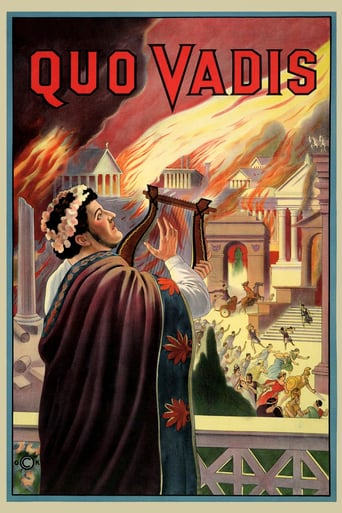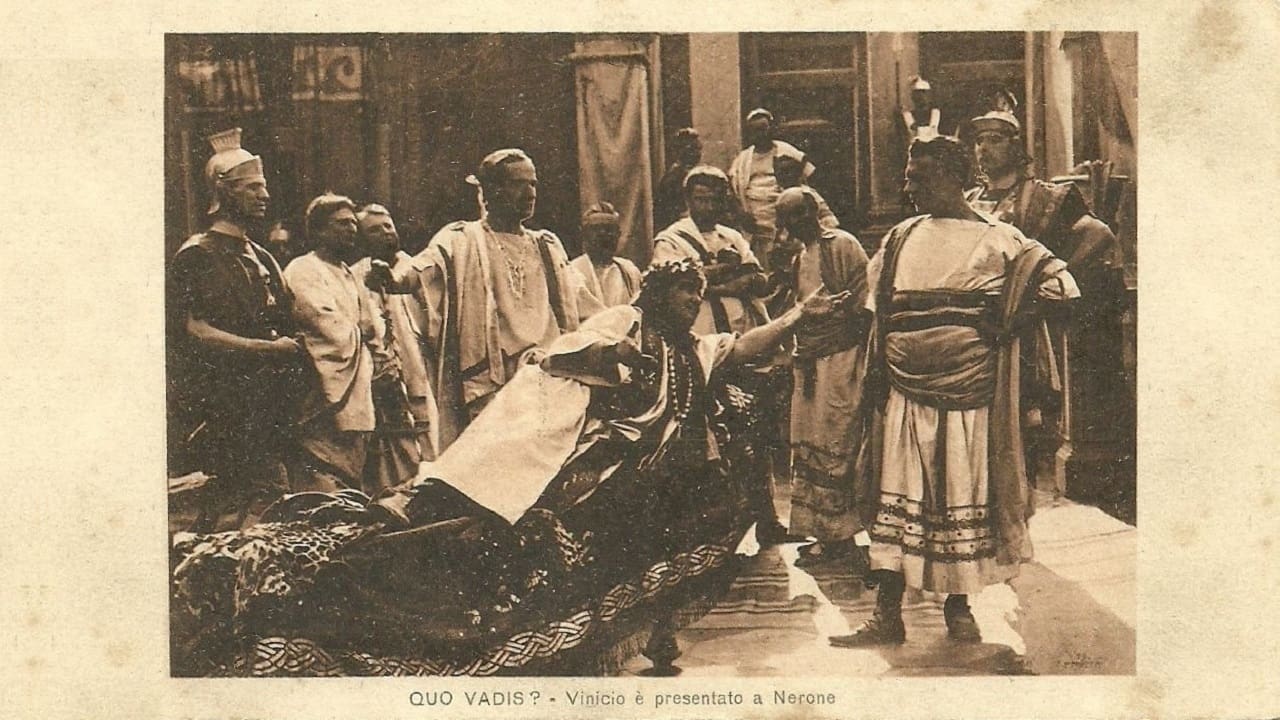Marcin Kukuczka
At the dawn of the cinema, it was Italy where actually great spectacles were born. They had the locations at hand. Along the famous CABIRIA made a few years later (which also celebrated its centenary), QUO VADIS by Enrico Guazzoni based faithfully upon Henryk Sienkiewicz's novel, not only stunned the audience of the time being played in many road theaters but also set the standards for the very genre (as many reviewers have stated before me). More to say, Sienkiewicz's novel became one of the top literary sources which inspired so many filmmakers to bring the first century Rome, the decadence and fall of emperor Nero (reigning 54-68 A.D) and the rise of Christianity in the center of the empire to screen. The most famous version enjoying the international renown to this day is, of course, Mervyn LeRoy's (1951). However, great as the ultra popular QUO VADIS is, this one appears to be more faithful to the novel but requires a very special perception. Allegedly, Henryk Sienkiewicz himself saw this motion picture which we can see now after the restoration co-financed by the Lumiere Project.Amleto Novelli, Carlo Cattaneo, Cesare Moltini, Lea Giunchi, Gustavo Serena...the cast of the time do not make any special impression on us these days. Similarly to stagy silent movies of the 1910s, they may appear as 'phantoms' moving within the frame of the screen without desirable close-ups that would instill some understanding of the characters' feelings. Yet, that is not the strength of the movie.The major phenomenon of this silent QUO VADIS (there was another silent version with Emil Jannings as Nero which occurred a flop) are the moments of great aesthetic intensity. Mostly operatic in its feeling, it supplies a viewer with an unbelievable 'image' of the novel's content. It is not the novel so to say 'filmed' or pictured but art of a new medium (at the time) which beautifully combines literature and cinema. With no words necessary, the movie does not disturb imagination but rather inspires its unknown spheres. From the banquet at Nero's through the fire of Rome, the shots of the arena and St Peter meeting Christ on the Appian Way (the climax of the story here though not so historically chronological), the scenes may still occur highly entertaining. We watch a distant past, we have a glimpse of early cinema's vision and both the storytelling and the execution of the content become to us quite 'archaic.' That aspect appears as tremendously involving.There is not much to say about performances, about music score, about special effects. Yet, there is something inspiring about depriving oneself of all the prefabricated expectations of an 'entertaining' movie, about beating the 'cliches' of 'silent film equals to boring film' and allowing oneself to view it in a fresh manner as if it still had something to offer after more than a century. And believe me, it does.
FerdinandVonGalitzien
"Quo Vadis?" (1913) was a landmark in early Italian historical epic films and certainly Herr Enrico Guazzoni's grand scale masterpiece laid the foundations for what genuine kolossal Italian spectacles should be. It had a great deal of influence on Herr Giovanni Pastrone's "Cabiria" 1914) and D.W. Griffith's "Intolerance" (1916).It is easy to see why "Quo Vadis?" shocked early silent audiences because even today to watch this astonishing oeuvre is like visiting an archaeological delicatessen and is a pleasure for silent fans. The film is a larger-than-life picture that was based on a Polish historical novel written by Henryk Sienkiewicz. The book was adapted for the silent and talkie screen many times but the story is so complex that it is hard to summarize in film form. There are a lot of Romans, an incendiary Caesar, many Christians and a horde of extras. Sometimes this Herr Graf got a little confused trying to remember who loves who and who is conspiring against whom."Quo Vadis?" is typical of Herr Guazzoni with his eye for details and his skill in using his big budget to maximum effect. The film is well paced and of course there are many great set pieces: Rome in flames, a chariot race and a coliseum full of gladiators, helpless Christians and very hungry lions. Besides the grand spectacle, the film includes also more prosaic subjects like morality and faith in reference to the early Christians and the struggle of this new religion and its human values in the face of Roman decadence and barbarism.In technical aspects, "Quo Vadis?" is a surprising oeuvre for its detailed framing wherein the depth of field works very effectively in focusing the viewer' s attention right where it needs to be when some much is happening on screen.Unfortunately "Quo Vadis?" hasn't had the well-earned praise of other similar Italian historical epic films; that's what usually happens with the pioneers. These early and innovative masters have their work copied by advanced pupils who end up with the fame and glory. As the German saying goes: "raise crows, and they'll gouge out your eyes"
And now, if you'll allow me, I must temporarily take my leave because this German Count must throw some servants into the Schloss' Coliseum arena.Herr Graf Ferdinand Von Galitzien http://ferdinandvongalitzien.blogspot.com
Solomon
Perhaps the best film made to its date, 'Quo Vadis?' is an astonishing masterpiece. At a time in which most movies comprised 2 reels (running for about 20-24 minutes) this early feature was certainly the best epic film till 'Cabiria' (1914) was released. Based on the memorable novel written by Henryk Sienwiewicz, this adaptation is more faithful to the book than the 1951 MGM version (this version was called 'Quo Vadis' without the final ?, for it was thought to be bad luck an interrogation mark at the end of a title). I haven't seen the 2001 polish version yet, which was submitted to the Academy Awards (but not nominated) as Best Foreing Language Film but, since it didn't get very positive reviews, I'd dare say this 'Quo Vadis?' is the very best of them all.First of all 'Quo Vadis'? was originally released in 1912 not in 1913, it premiered all over the world in 1913: USA, Spain, Poland, France... But the original Italian release was in 1912. Now, over a year ago the existence of this film was unknown by many people who were asking over and over whether or not this one was available. There was only one review on the film here and the IMDb claimed it was a lost film so there was a lot of talk about it! Nothing further from the truth, ever since I uploaded it on youtube, doubts have been vanished.'Quo Vadis?' is a maserpiece for its date. The portrayal of Nero and all the characters is very accurate, the epic scenes with Rome in the background or the circus, extras, dialogs... Everything is awesome! The dialogs especially are very accurate too, saying as much as needed to make the complex story understandable, not saying too much but not too little either, just the right words. If you're into early film history this is certainly a must-see!! If you like epic movies, roman atmosphere, this kind of literature or whatever topic related to this particular movie this is a must-see. And if you aren't into silent films but you'd ever consider watching one, this is a good choice. Though not as good as Caligari, Potemkin or Nosferatu (after all film techniques would evolve a lot within the next few years), very worth watching either way.
MARIO GAUCI
In the brief introduction preceding the copy I have acquired of this seminal Italian 'kolossal', the hyperbolic epithets of "classic" and "masterpiece" are freely bandied about; while I would not go so far as to use those very words myself in connection with this particular Silent film version of QUO VADIS? (itself the second of 6 film adaptations over the course of a century!), I would gladly agree to call it a milestone – for Italian cinema in general, for the epic genre specifically and, most importantly, for the art of the feature film worldwide. Although MGM's opulent 1951 Technicolor version is easily the most popular of the lot, it is quite remarkable how the actors portraying Roman Consul Marcus Vinicius, Senator Petronius and Emperor Nero here resembled the ones in Mervyn Le Roy's remake – namely Robert Taylor, Leo Genn and Peter Ustinov respectively! Conversely, while Patricia Laffan's sensuous Poppea left an indelible mark in the later Hollywood epic, the frumpy actress playing her in the version under review is anything but memorable. The Greek slave who turns Vinicius' head (and life upside down), then, is portrayed by an actress who, it seemed to me, was way too young for the role but, while her giant servant lacked the magnetism of Buddy Baer, acquitted himself reasonably well in the circumstances. The copy I acquired was clearly a battered-but-watchable one of French origin, accompanied by horrendous computer-generated English intertitles replete with spelling mistakes! As usual with early Silent movies, the overtly theatrical mannerisms affected by the actors gives rise to some unintentionally risible moments; the hot-tempered Vinicius, forever on the verge of slapping his inferiors around, is a particular liability in this regard. Still, like any self-respecting epic to which it paved the way, the overall success of QUO VADIS? is ultimately measured by the spectacle (or lack thereof) on display during the several climaxes integrated into the narrative and, incredibly enough for a movie that is almost a century old, I can safely say that this version of QUO VADIS? does not disappoint: Nero's lavish parties, the burning of Rome, gladiatorial combat in the arena, lions feasting on Christian prisoners (apparently, an unlucky extra became an all-too-real meal for the bloodthirsty felines but, mercifully, the footage does not seem to have been incorporated into the finished film!) and, last but not least, Jesus Christ's apparition to St. Peter on the Appian Way (which meeting, of course, spawned the novel and film's very title).


 AD
AD
